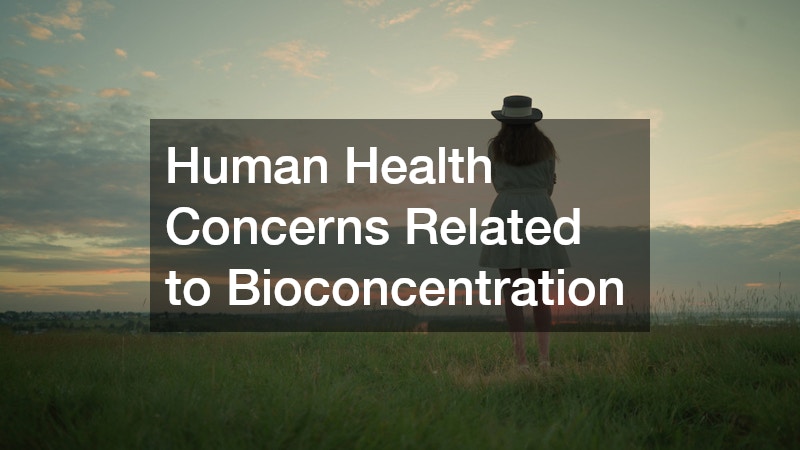The intricacies of our natural world often reveal processes that, while out of sight, play a pivotal role in environmental and human health. One such process is ” bioconcentration,” a phenomenon that significantly influences the way pollutants interact with both ecosystems and organisms. At its core, bioconcentration describes the accumulation of a chemical substance in an organism at a rate higher than its ambient environmental concentration, primarily through respiration or dermal absorption.
Understanding bioconcentration is crucial, as it can lead to the toxicity of chemicals within biological systems, posing risks not only to wildlife but also to human health through food chains. This article explores the implications of bioconcentration, its environmental impact, and the associated health concerns for humans.
Environmental Impact of Bioconcentration
Bioconcentration significantly impacts aquatic environments, where many pollutants are first introduced. Aquatic organisms, such as fish and mollusks, can accumulate chemicals like heavy metals, pesticides, and industrial compounds present in their surroundings. The persistent nature of these substances means that they do not easily degrade, leading to long-term exposure that can alter biological functions in aquatic organisms. Over time, bioconcentration can result in bioaccumulation and biomagnification, where concentrations increase at each trophic level, severely affecting entire aquatic ecosystems. Consequently, this can lead to reduced biodiversity, as sensitive species either adapt, migrate, or face potential extinction.
The implications of bioconcentration extend beyond aquatic life, influencing terrestrial ecosystems as well. Animals that rely on aquatic organisms for food are indirectly affected, ingesting contaminants through their diet. This is especially evident in birds and mammals at the higher end of the food chain, often leading to reproductive issues and developmental abnormalities in offspring. Predatory relationships within ecosystems mean that even terrestrial animals are not safe from the hazards introduced to aquatic environments. Additionally, plants can absorb contaminants through water sources, which can then be transferred to herbivores. This interconnectedness illustrates the widespread environmental impact of bioconcentration, making it a pressing concern for conservation efforts.
Human activities, such as industrial discharge and agricultural runoff, are primary catalysts for the introduction of harmful substances into the environment, increasing bioconcentration risks. Urbanization and deforestation further exacerbate pollution levels, disrupting natural filtration systems and increasing contaminant dispersion. The long-lasting presence of these pollutants does not just threaten biodiversity but also ecosystem services, such as clean water and fertile soil, that are vital for sustaining human life. Strategies to mitigate these effects include improving waste management, stricter regulation of pollutants, and adopting sustainable agricultural practices. Addressing the source of contaminants is essential to minimizing bioconcentration and preserving ecosystem integrity.
Human Health Concerns Related to Bioconcentration
Bioconcentration presents direct and indirect health risks to humans, predominantly through the consumption of contaminated water and food. Persistent organic pollutants, which are known for their long-term stability, can accumulate in fish and shellfish, posing major health risks to populations that rely on seafood as a dietary staple. These contaminants are linked to adverse health effects, such as cancer, endocrine disruption, and neurological disorders. Vulnerable populations, including children and pregnant women, are particularly at risk due to their increased sensitivity to toxic exposures. Awareness and education on the sources and risks of bioconcentrated chemicals are key to reducing these health impacts.
In addition to ingestion, human health is also at risk through dermal contact and inhalation of volatile compounds released into the air from polluted waters. These exposure routes can result in immediate as well as chronic health issues, making regulation and monitoring critical components of public health strategies. Occupational exposure in industries working with hazardous substances further emphasizes the need for safety measures and protective equipment. Governments and health organizations play a crucial role in research and surveillance to identify at-risk areas and populations. Public health interventions focused on reducing pollution sources and promoting safer alternatives are vital in combating the detrimental effects of bioconcentration on human health.
Addressing the human health concerns associated with bioconcentration requires global cooperation and proactive policy frameworks. International agreements, such as the Stockholm Convention, aim to eliminate or restrict the production and use of persistent organic pollutants, acknowledging their substantial impact on both environmental and human health. National and local policies also need to be enforced to ensure compliance with environmental standards and the promotion of green technologies. Individual actions, like choosing eco-friendly products and supporting sustainable practices, contribute to collective efforts in reducing bioconcentration risks. Through collaborative approaches, significant strides can be made towards mitigating the health impacts of bioconcentration globally.
